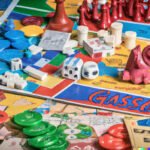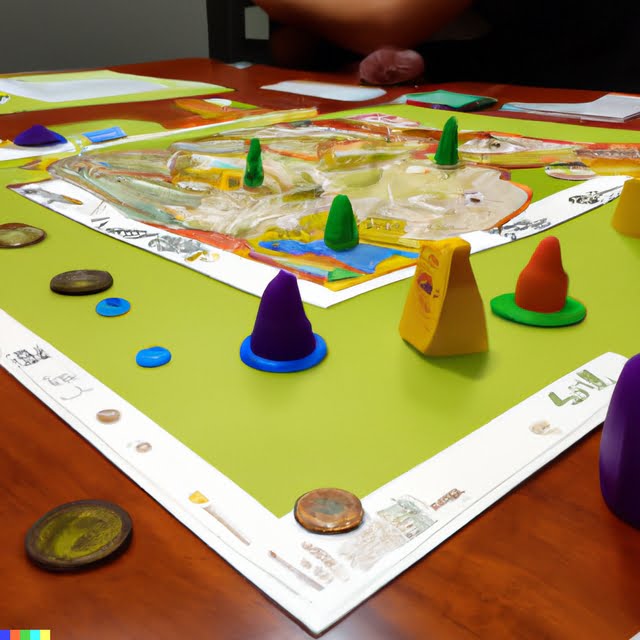Are you a fan of board games and looking for a new creative project? Creating your own homemade strategy board game can be an exciting and rewarding endeavor.
Whether you are a seasoned game designer or just starting out, designing your own game can be a fun and challenging experience.
In this article, we will explore the world of homemade strategy board games, including the benefits of creating your own game, materials needed, step-by-step guide to design and planning, testing and refining tips, creating rules and instructions, artwork and design tips, prototyping and production advice, and the joy of creating and playing your own homemade strategy board game.
Designing and playing homemade board games have been gaining popularity as people seek unique forms of entertainment that they can create themselves. A homemade strategy board game is a type of game that typically involves strategic thinking, decision-making, and planning skills. Whether it’s for personal enjoyment or to share with family and friends, creating your own board game allows you to customize the experience to suit your preferences.
In the following sections, we will delve deeper into the process of creating a homemade strategy board game from start to finish. We will discuss the benefits of making your own game, provide tips for designing and testing your game effectively, offer advice on prototyping and production, as well as share insight on bringing your unique creation to life. Let’s embark on this creative journey together as we explore the wonderful world of homemade strategy board games.
Benefits of Creating Your Own Strategy Board Game
Creating your own homemade strategy board game can be not only a fun and fulfilling experience but also has numerous benefits. One of the primary advantages is the opportunity to exercise your creativity.
By designing your own game, you have the freedom to come up with unique concepts, rules, and gameplay mechanics, allowing your creativity to truly shine. This process can also help improve problem-solving skills as you work through challenges such as balancing game elements or creating fair rules.
Another benefit of creating your own strategy board game is the potential for personalization. When you make your own game, you have the chance to incorporate personal themes, inside jokes, or references that are meaningful to you and your intended players. This level of customization can enhance the gaming experience and make it more enjoyable for everyone involved.
In addition, crafting a homemade strategy board game can also be a cost-effective alternative to purchasing commercially produced games. By using materials you already have or acquiring affordable supplies, you can create a high-quality game without breaking the bank. This DIY approach also allows for flexibility in terms of design and components, giving you greater control over the final product.
| Benefits | Description |
|---|---|
| Creativity | Design unique concepts and rules; improve problem-solving skills |
| Personalization | Incorporate personal themes and inside jokes; enhance gaming experience |
| Cost-effectiveness | Create high-quality game without spending too much money; flexibility in design and components |
Materials Needed for Making a Homemade Strategy Board Game
Creating your own homemade strategy board game can be a fun and rewarding experience. One of the first steps in the process is gathering all the necessary materials needed to bring your game to life. The good news is that you don’t need a lot of fancy or expensive supplies to get started. In fact, many of the items you may need could already be found around your home or easily obtained at a local craft store.
First and foremost, you will need a sturdy board to serve as the base for your game. This can be a piece of cardboard, wood, or even an old game board that you repurpose for your new creation. Additionally, you will need playing pieces such as pawns, tokens, or miniatures to represent the players in your game. These can be made from various materials like wood, plastic, or even colorful buttons.
Another essential material is creating cards if your game involves drawing cards for certain actions or events. For this, you can use index cards or cardstock to create your own custom deck. If your homemade strategy board game involves dice rolling, then obtaining dice would also be necessary for playing the game.
| Materials | Examples |
|---|---|
| Board | Cardboard, Wood, Old repurposed game board |
| Playing Pieces | Wooden pawns, Plastic tokens, Colorful buttons |
| Cards | Index cards, Cardstock |
| Dice | Standard six-sided dice |
Step-by-Step Guide to Designing and Planning Your Homemade Strategy Board Game
Designing and planning your own homemade strategy board game can be a fun and rewarding creative process. Here is a step-by-step guide to help you bring your game idea to life:
1. Brainstorm Your Game Concept: Start by brainstorming ideas for your game. What theme or concept do you want to explore? What are the main objectives of the game? Consider the type of strategy and decision-making you want the players to engage in.
2. Create a Game Map or Board Layout: Once you have a concept in mind, it’s time to create the visual representation of your game. Use pen and paper or design software to sketch out the layout of the game board, including spaces, paths, and any other features necessary for gameplay.
3. Develop Game Mechanics: Determine the rules and mechanics of your game. How will players move around the board? What actions can they take? Consider how elements such as dice, cards, or tokens will be used in gameplay.
4. Establish Victory Conditions: Decide how a player can win the game. Will it be through accumulating points, reaching a certain goal, or achieving specific objectives? Victory conditions will help shape the overall strategy and gameplay experience.
5. Create Game Pieces and Components: Assemble any necessary materials such as cards, tokens, or playing pieces. Decide on dimensions, colors, and designs that align with your game’s theme.
6. Test Your Game: Before finalizing your homemade strategy board game, it’s important to test it out with friends or family members. Take note of their feedback and make adjustments as needed before moving on to final production.
By following these steps systematically, you can turn your ideas into reality and create a unique homemade strategy board game that offers hours of entertainment for you and others who play it.
Tips for Testing and Refining Your Homemade Strategy Board Game
Testing and refining your homemade strategy board game is an essential step in ensuring that it is fun, challenging, and well-balanced. Here are some tips to help you with this process:
1. Playtest with Friends and Family: Gather a group of friends or family members to playtest your homemade strategy board game. Observe their reactions, take notes on any issues or confusion that arises during gameplay, and ask for honest feedback.
2. Make Iterative Changes: Based on the feedback from playtesting, make iterative changes to your homemade strategy board game. This could include adjusting the rules, balancing the game mechanics, or tweaking the components to improve the overall gameplay experience.
3. Consider Different Player Counts: Test your homemade strategy board game with different player counts to see how it scales. Some games may work better with a larger group, while others may be more enjoyable with a smaller number of players.
4. Balance Luck and Skill: It’s important to strike a balance between luck and skill in your homemade strategy board game. Too much luck can make the game feel arbitrary, while too much emphasis on skill can make it inaccessible to casual gamers.
5. Seek Feedback from Board Game Communities: Share your homemade strategy board game with online communities or local gaming groups to get feedback from experienced gamers. Their insights can help you identify areas for improvement and refine your game further.
By following these tips for testing and refining your homemade strategy board game, you can ensure that it is engaging, balanced, and ready for countless hours of strategic enjoyment.
How to Create Rules and Instructions for Your Homemade Strategy Board Game
Creating rules and instructions for your homemade strategy board game is an essential step in the process of bringing your game to life. Clear, concise, and easy-to-understand rules are crucial for ensuring that players can enjoy the game without confusion or frustration. Here are some tips on how to create effective rules and instructions for your homemade strategy board game.
First, start by outlining the objective of the game. What is the ultimate goal that players must strive for? Clearly define what constitutes a win, which will serve as the driving force behind players’ actions throughout the game. Next, detail the setup process, including how to assemble the game board, distribute pieces or cards, and any other necessary preparations before gameplay begins.
Once the setup is established, outline the basic gameplay mechanics. How do players take turns? What actions can they perform during their turn? Are there specific rules for moving pieces or utilizing resources? Clearly explain each aspect of gameplay to ensure that players understand how to interact with the game system.
In addition to gameplay mechanics, it’s important to address any special cards, abilities, or unique features of your homemade strategy board game. Provide detailed descriptions of these elements and how they affect gameplay. It’s also helpful to include example scenarios or illustrations to further clarify how these components function within the game.
By creating comprehensive and well-defined rules and instructions for your homemade strategy board game, you can ensure that players have a smooth and enjoyable gaming experience. Furthermore, clear guidelines will make it easier for you to teach others how to play your game and will contribute to its overall playability and appeal.
Artwork and Design Tips for Your Homemade Strategy Board Game
When creating your homemade strategy board game, the artwork and design play a crucial role in attracting players and enhancing the overall gaming experience. Here are some tips to help you make your game visually appealing and engaging:
Theme and Concept
Before diving into the artwork and design process, it’s essential to establish a clear theme and concept for your homemade strategy board game. Whether it’s a fantasy adventure, historical war, or futuristic space exploration, the theme will guide the visual elements of the game, from the illustrations on the board to the character designs.
Color Scheme and Visual Hierarchy
Selecting a cohesive color scheme is important for ensuring that your homemade strategy board game is visually appealing. Consider using colors that complement each other and evoke the desired atmosphere of your game’s theme. Additionally, create a visual hierarchy by using color, size, and contrast to prioritize important elements such as key game components or strategic areas on the board.
Illustrations and Graphics
Incorporating high-quality illustrations and graphics can significantly enhance the immersive experience of your homemade strategy board game. Whether you’re creating character cards, action tokens, or the game board itself, investing time in detailed and captivating artwork can make your game stand out.
By paying attention to these artwork and design tips, you can transform your homemade strategy board game into a visually stunning and captivating gaming experience for players. Remember that while gameplay mechanics are essential, excellent artwork and design can elevate your game to new heights of enjoyment.
Bringing Your Homemade Strategy Board Game to Life
So, you’ve designed and tested your homemade strategy board game, and now it’s time to bring it to life through prototyping and production. This stage of the process is where your game really starts to take shape, and you can see your hard work come to fruition. Here are some tips for bringing your homemade strategy board game to life through prototyping and production.
First, when it comes to prototyping your homemade strategy board game, don’t be afraid to start with simple materials. You can use cardboard, markers, and other household items to create a basic prototype of your game board and pieces. This will allow you to test the gameplay and make any necessary adjustments before investing in more professional materials.
Once you’re happy with the gameplay and overall design of your homemade strategy board game, it’s time to move into the production phase. Depending on your budget and resources, you may choose to produce your game on a small scale or look into larger-scale production options. Research different manufacturing methods, such as 3D printing or traditional board game manufacturing companies, to determine the best fit for your game.
Finally, consider how you will package and distribute your homemade strategy board game once it’s been produced. Will you sell it online through a platform like Etsy or Kickstarter? Or will you create physical copies to sell at local markets or stores?
Make sure to create eye-catching packaging that reflects the theme and style of your game, as this will be the first thing potential players see. By following these tips for prototyping and production, you can turn your homemade strategy board game from a concept into a tangible product ready for others to enjoy.
Conclusion
In conclusion, creating and playing your own homemade strategy board game can be a rewarding and fulfilling experience. Not only does it allow for creativity and self-expression, but it also provides numerous benefits such as enhancing problem-solving skills, fostering teamwork, and promoting strategic thinking. By designing and crafting your own game, you have the opportunity to tailor it to your preferences, making it a unique and personalized gaming experience.
Furthermore, the process of creating a homemade strategy board game can be an enjoyable and educational activity for individuals of all ages. It encourages innovation, critical thinking, and attention to detail. Additionally, the sense of accomplishment that comes from seeing your game come to life can be immensely satisfying.
Ultimately, the journey of designing, testing, refining, and producing your homemade strategy board game is an exciting adventure that offers endless possibilities for fun and entertainment. Whether you are interested in creating a game for personal enjoyment or for sharing with friends and family, the joy of bringing your ideas to fruition through a homemade strategy board game is truly unmatched.
So roll up your sleeves, gather your materials, and let your imagination run wild as you embark on the wonderful journey of creating your very own homemade strategy board game.
Frequently Asked Questions
How Do You Create a Game Strategy?
Creating a game strategy involves understanding the rules, objectives, and limitations of the game. It also requires analyzing the strengths and weaknesses of both your own position and your opponents’. Adaptability and flexibility in your approach are also crucial in developing a successful game strategy.
How Can I Make My Own Board Game?
Making your own board game can be a fun and creative process. Start by brainstorming a unique concept or theme for your game. Then, create a set of rules, design the game board and pieces, and test it with friends and family to make sure it’s enjoyable and balanced.
What Is the Board Game That Involves Strategy?
There are many board games that involve strategy, but one popular example is “Settlers of Catan.” In this game, players must strategically build roads, settlements, and cities while trading resources with other players to accumulate victory points.
Other strategic board games include “Risk,” “Chess,” “Ticket to Ride,” and “Puerto Rico.” Each requires careful planning, decision-making, and foresight to outmaneuver opponents.

I love playing all kinds of games – from classics like Monopoly to modern favourites like Ticket to Ride.
I created this blog as a way to share my love of board games with others, and provide information on the latest releases and news in the industry.





